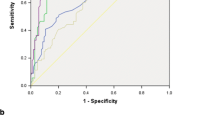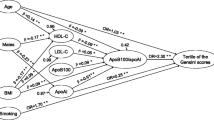Abstract
More than 300 risk factors for coronary artery disease (CAD) have been described. There are important geographical and racial differences in both the prevalence of CAD and of potential risk factors.
The purpose of this study was to determine the relationship between both the presence and extent of angiographically defined CAD in an Irish population and a spectrum of clinical risk factors, lipid profile and haemostatic variables. On univariate analysis, age, male gender, history of smoking, history of hypertension, total cholesterol, triglycerides, LDL, Cholesterol, the LDL:HDL ratio, apoprotein B-100 and the apoprotein B-100:A-II ratio were associated with the presence of CAD. However, in multivariate analysis only age, male gender, a history of smoking and the apoptrotein B-100: A-II ratio remained significantly associated with the presence of CAD. These same risk factors and apoprotein B-100 were significantly associated with the extent of CAD on multivariate analysis. In addition, apoprotein B-100 levels appeared to be associated with disease extent.
When all significant variables associated with the presence or extent of CAD were analysed together in a multivariate model, they only accounted for 28% of the variability in the distribution of CAD.
Thus, advancing age, male gender, cigarette smoking and apoprotein B-100 appear to be important correlates of the presence and extent of CAD in this selected population. However, in individual patients most of the variability in the distribution of occlusive CAD remains unexplained.
Similar content being viewed by others
References
Tuomilehto, J., Kuulasmaa, K. WHO MONICA project: Assessing CHD mortality and morbidity. Int. J. Epidemiol. 1989; 18(3): 38–45.
CASS principal investigators and their associates. Coronary artery surgery study (CASS): a randomized trial of coronary artery bypass surgery. Circulation 1983; 68: 939–50.
Kannel, W., D’Agostino, R. B., Nelanger, A. Fibrinogen, cigarette smoking and the risk of cardiovascular disease: Insights from the Framingham study. Am. Heart J. 1987; 113(4): 1006–1010.
Romm, P. A., Green, C. E., Reagan, K., Rackley, C. E. Relation of serum lipoprotein cholesterol levels to presence and severity of angiographic coronary artery disease. Am. J. Cardiol. 1991; 67(6): 479–83.
Luria, M. H., Erel, J., Sapoznikov, D., Gotsman, M. S. Cardiovascular risk factor clustering and ratio of total cholesterol to high-density lipoprotein cholesterol in angiographically documented coronary artery disease. Am. J. Cardiol. 1991; 67(1): 31–6.
Perez, G. O., Mendez, A. J., Goldberg, R. B., Duncan, R., Palamo, A. Correlates of atherosclerosis in coronary arteries of patients undergoing angiographic evaluation. Angiology 1990; 41(7): 525–32.
Aronov, D. M., Eganian, R. A., Kovaleva, O. F., Zhidko, N. I., Dannelov, G. E., Rozhnov, A. V. Comparative evaluation of nutrition and lipid profiles in a Russian population with preclinical ischaemic heart disease and with marked coronary artery disease. Kardiologiia 1991; 31(6): 61–4.
Dave, T. H., Wasir, H. S., Prabhakaran, D., Dev, V., Rajani, M., Venugopal, P., Tandon, R. Profile of coronary artery disease in Indian Women: correlation of clinical, noninvasive and coronary angiographic findings. Indial Heart J. 1991; 43(1): 25–9.
Olsson, A., Holmquist, L., Walldius, G., Hadell, K., Carlson, L., Riccardi, G., Rubba, P., Pauciullo, P., Mancini, M. Serum apolipoproteins, lipoproteins and fatty acids in relation to ischaemic heart disease in northern and southern European males. Acta Med. Scand. 1988; 223: 3–13.
Durrington, P., Hunt, L., Ishola, M., Arrol, S., Bhatnagar, D. Apolipoproteins (a), A-I and B and parental history in men with early onset ischaemic heart disease. Lancet 1988; i: 1070–75.
Newman, W, Freedman, D., Voors, A., Gard, P., Srinivasan, S., Cresanta, J., Williamson, G. D., Webber, L., Berenson, G. Relation of serum lipoprotein levels and systolic blood pressure to early atherosclerosis — The Bogalusa heart study. N. Engl. J. Med. 1986; 314: 138–44.
Buring, J., O’Connor, G., Goldhaber, S., Rosner, B., Herbert, P., Blum, C, Breslow, J., Hennekens, C. Decreased HDL2, HDL3, cholesterol, apoprotein A-I and apoprotein A-II and increased risk of myocardial infarction. Circulation 1992; 85: 22–29.
Hamsten, A. Apolipoproteins, dyslipoproteinemia and premature coronary heart disease. Acta Med. Scand. 1988; 223: 389–403.
Dahlen, G. A., Guyton, J., Attar, M., Farmer, J., Kautz, J., Gotto, A. Association of levels of lipoprotein (a), plasma lipids and other lipoproteins with coronary artery disease documented by angiography. Circulation 1986; 74(4): 758–65.
Armstrong, V. W., Cremer, P., Eberle, E., Manke, A., Schulze, F., Wieland, H., Kreuzer, H., Seidel, D. The association between serum Lp(a) concentrations and angiographically assessed coronary atherosclerosis-dependence on serum LDL levels. Atherosclerosis 1986; 62: 249–57.
Genest, J., Jenner, J., McNamara, J., Ordovas, J., Silberman, S., Wilson, P., Schaefer, E. Prevalence of lipoprotein (a) excess in coronary artery disease. Am. J. Cardiol. 1991; 67: 1039–45.
Scmitz-Heubner, U., Thompson, Sg., Balleisen, L., Fechtrup, C, Gross-Heitmeyer, W., Kirchoff, B., Most, E., Muller, U. S., Seiffert, C, Seiffert, D., Van de Loo, J. Lack of association between haemostatic variables and the presence or the extent of coronary atherosclerosis. Br. Heart J. 1988; 59: 287–91.
Meade, T. W., Brozovic, M., Chakrabarti, R. R., Stirling, Y., Thompson, S. G. Haemostatic function and ischaemic heart disease principal results of the Northwick Park Heart study. Lancet 1986; i: 533–537.
Yernell, J., Baker, I., Sweetnam, P., Bainton, D., O’Brien, J., Whitehead, P., Elwood, P. Fibrinogen, viscosity and white blood cell count are major risk factors for ischaemic heart disease. Circulation 1991; 83: 836–44.
Handa, K., Kono, S., Saku, K., Sasaki, J., Kawano, T. Plasma fibrinogen levels as an independent indicator of severity of coronary atherosclerosis. Atherosclerosis 1989; 77 (2–3): 209–13.
Author information
Authors and Affiliations
Rights and permissions
About this article
Cite this article
Galvin, J., Codd, M., Leavy, S. et al. Lipid profile, haemostatic variables and angiographically-defined coronary artery disease: A cross-sectional study in an Irish population. I.J.M.S. 165, 129–132 (1996). https://doi.org/10.1007/BF02943801
Issue Date:
DOI: https://doi.org/10.1007/BF02943801




